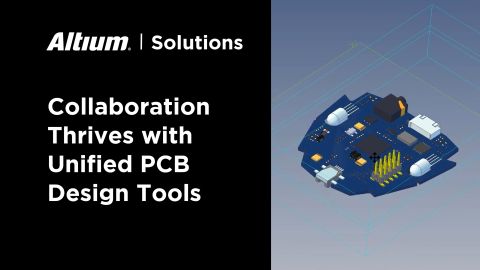Cloud Collab Design: How Collaboration Changes with the Cloud
In this series of posts, we’ll take a good, hard look at how Cloud solutions play into the design and development of board systems. That includes detailing use cases for procurement, manufacturing, quality, service, and many more. However, before we go down that path, we need to cover some basics. You see, there are some general-isms that apply in each of these use cases. We’ll detail them here and reference them there.
So, what’s our general-ism for today? First, let’s look at how collaboration changes when Cloud technologies are the enabler. Next, we’ll contrast it with a variety of other technology enablers. Where do we start? Email.
Email as a Collaboration Enabler
Email. Everyone has it.
It acts as the lowest common denominator. You can easily attach a file and send it off. You can feel confident that the person receiving the email will get that attachment. There’s comfort in that reality.
There are, however, serious issues with using email as a collaboration tool. For instance:
- Emails can be deleted, buried, or lost. If that happens, there’s no reminder for the recipient that something bad has happened. It takes some kind of project manager for the collaborators to realize something went awry.
- Email attachments can also quickly become outdated. Someone might send an email with a file attached and then change the file on their computer. Now the recipients are working with out-of-date information.
- Merging multiple simultaneous changes is time-consuming. A person might send out an email with an attachment to five people, asking for feedback. Each recipient of that file then makes changes and sends it back. The original sender must now manually incorporate five different sets of changes.
- Email is not safe for intellectual property. Emails, especially ones like interactive emails and external emails, travel through intermediary servers. Such emails can be intercepted or hacked, putting your intellectual property at risk.
Obviously, these issues range from inconvenient to threatening. However, the takeaway is fairly straightforward: email isn’t a great tool for collaboration despite its ubiquity.
File Sharing Services as a Collaboration Enabler
There’s no doubt about it: this type of solution boomed since its introduction roughly ten years ago. The idea is incredibly attractive. You upload a file to the Cloud-based service. You share it with someone else via email. They access it directly using their own login.
This approach has distinct advantages over email. There’s no file attachment in an email. That means it is fairly secure. The file is held in a centrally accessible location in the Cloud. That means everyone inside and outside the company can access it easily.
However, other issues arise when using a Cloud-based file sharing service to enable collaboration, including the following:
- The file-based approach still requires merging multiple simultaneous changes. You download the file instead of saving it from the email. Yet, you still have the same problem. Asking five people to review will still result in five different files where you have to merge changes.
- There is no persistent task for people. Email is still the method of asking someone to do something with the file. That request email can still get lost, deleted, or buried.
- A downloaded file can quickly become outdated. The person who originally uploaded the file can upload another updated file. However, if someone downloaded the original, they won’t know it’s out of date without notice, and many services don’t send such a notification email. As with email file attachments, there’s a danger that people could be working off the wrong information.
As you can see, Cloud-based file sharing services address one or two of the concerns with using email for collaboration, but there are many ugly spots.
On-Premise Enterprise Solutions as a Collaboration Enabler
Now, here we go. Big box enterprise solutions will surely solve this problem. Right?
The idea here is that server software like Product Lifecycle Management (PLM) or Enterprise Resource and Planning (ERP) is installed within a company. These software platforms can hold files and more information about board systems.
These systems address a number of the shortcomings with email and file sharing services. Nevertheless, numerous problems persist. For instance:
- Access from outside the company is difficult. Such systems sit behind a company’s firewall. To provide access to suppliers and customers, you often have to set up some kind of intermediary server in the DMZ (the wilds of the Internet). Then you have to synch only certain pieces of information back and forth. It requires effort and corporate IT.
- Designs are still file-based. These systems can act as a single source of the truth, offering the latest version of a file to whomever accesses it. However, the point of failure is that files are still be passed around. You still have to merge multiple simultaneous changes from many people.
These systems offer real promise. But it is important to recognize their faults and plan accordingly.
Cloud-Based Solutions as a Collaboration Enabler
Wait. You’re right. This does sound familiar. Cloud-based file sharing services and Cloud-based solutions are both in the Cloud. However, there is one significant and fundamental difference: Cloud-based solutions do not have files. That different might sound simple and insignificant. But it’s a whopper. Let me explain.
In Cloud-based solutions, people invite others to the design or document or something else. To access that thing, those other people open it up in their browser instead of downloading and opening it in a software application. In true Cloud-based solutions, multiple people can open that same thing simultaneously. This means they can see each other in the context of that thing.
Now, the way these Cloud-solutions work has some interesting implications.
- Changes from multiple people happen to one thing simultaneously. Because everyone is accessing the same thing, which exists in the Cloud, their changes and suggestions occur simultaneously within that one thing.
- People see each other’s changes instantly. Because everyone is accessing the same thing simultaneously, and getting updates instantaneously, everyone can see everyone else’s changes in real time.
Takeaways
In future posts, we’ll be citing this topic again and again. It is central to the value that many organizations can reap from a solution that supports the development of board systems in the Cloud. Collaboration has long been extremely painful. And while many might not know it yet, collaboration in the Cloud yields a lot of benefits.












